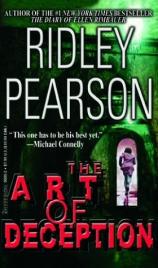The Art of Deception
Review
The Art of Deception
The backstory to THE ART OF DECEPTION, while not as interesting as
the novel itself, is more interesting than any number of novels you
might pick up at random. Longtime fans of Ridley Pearson will
recall his 1988 novel UNDERCURRENTS. What isn't widely known is
that Pearson was subsequently contacted by a law enforcement office
and advised that the research he had done while writing
UNDERCURRENTS was used to solve an actual homicide. Pearson, in
turn, has taken that case and based on it THE ART OF DECEPTION.
Life imitates art, which imitates life, if you will.
THE ART OF DECEPTION marks the return of Seattle Police forensic
psychologist Daphne Mathews and Lieutenant Lou Boldt as well as
that of the recently introduced John LaMaoi. THE ART OF DECEPTION
begins with the final minutes in the life of Mary-Ann Ridley, a
troubled young woman in an abusive relationship. The reader is
introduced, by turns, to the primary people in her life at the time
of her death: Lanny Neal, her abusive boyfriend, an obnoxious,
immediately unlikable sort who is a walking waste of air; and
Ferrell Walker, Mary-Ann's brother, who walks a fine line between
sanity and obsessive madness, not always successfully. Mathews,
still haunted by the suicide of a teenage runaway she had been
counseling, throws herself into the investigation.
She is also thrown together with LaMaoi, to whom she feels a
surprising but not unwelcome, developing attraction. Walker,
however, interjects himself into the middle of the investigation,
insisting that Neal is the murderer and sets about attempting to
prove it. He also, to Mathews's gradual and uneasy dismay,
interjects himself into her life. Seattle and the police
department, meanwhile, are reeling over the separate disappearances
of two women whose vanishing is so devoid of clues as to make it
seem as if they have been plucked off of the face of the earth.
When a hotel peeping tom seems to provide a link to the
disappearances, Boldt, then LaMaoi and Mathews, are led into
Seattle's Underground --- the preserved remnants of the old city
buried by the building of the new. The two cases dovetail when
Walker demonstrates knowledge of the disappearances. Mathews,
accordingly, must attempt to elicit as much as she can from Walker
without giving him encouragement, unaware that the closer she gets
to solving Ridley's murder the more she places her own life in
danger.
Pearson's writing has never been more compelling; his descriptions
of Seattle's Underground --- not the limited section displayed
during the tours, but the good stuff that the commoners never get
to see --- are addictive. One can feel the walls closing in as we
follow the protagonists while they pursue their quarry, racing
against time. Pearson's villains of the piece are at once highly
believable and unbelievably creepy. His descriptions are brief but
specific, as if they are nightmares glimpsed through open doors
while running down a hallway. Pearson also continues to develop the
personalities of his characters, infusing in them a believability
that compels the reader to care about them long after the final
page is read. Pearson, already an excellent writer, continues to
grow and to hone his sharp eye for description to an even finer
edge. Those encountering him for the first time in THE ART OF
DECEPTION will want to peruse his seductive backlist to see what
has gone before while they wait impatiently for what is to come
next.
Reviewed by Joe Hartlaub on January 20, 2011





